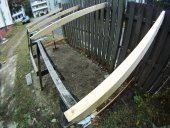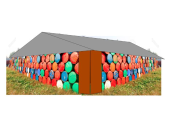









So, if I'm understanding you correctly, your goal is to have the rain water infiltrate on the driveway, and not run off? If that is the case then you will probably want to have a lot more rock and less clay and lime. In fact, I would think that having clay and lime involved might be quite contrary to your purposes. The rounder the rocks, the better the drainage. Add a layer of rougher rock near the surface for traction if you like. I would go with straight rocks.I cannot let the water just run down the hill because it floods the neighbor homes, so ditches are out.
"Never doubt that a small group of thoughtful, committed citizens can change the world; indeed, it's the only thing that ever has."-Margaret Mead "The only thing worse than being blind, is having sight but no vision."-Helen Keller





List of Bryant RedHawk's Epic Soil Series Threads We love visitors, that's why we live in a secluded cabin deep in the woods. "Buzzard's Roost (Asnikiye Heca) Farm." Promoting permaculture to save our planet.
 4
4




 2
2




Travis Johnson wrote:There is not really enough information here to make a recommendation, because I am not sure of where you live or the laws thereof. Still it sounds like you live in an existing house with a steep driveway?
Stefanie Chandler wrote:I am on a steep (100ft clime driveway). I cannot let the water just run down the hill because it floods the neighbor homes, ...
It seams like a natural solution to me but taking into consideration that I have NO training and NO education I am probably overlooking something. But What?
Invasive plants are Earth's way of insisting we notice her medicines. Stephen Herrod Buhner
Everyone learns what works by learning what doesn't work. Stephen Herrod Buhner




Creating sustainable life, beauty & food (with lots of kids and fun)
 2
2


















I agree with Travis, but I see where you are at too Jim. Travis, in Permaculture, as far as following the teachings of the design science, it is based on the ethics of Earth Care and People Care. Jim makes valid points, as do you. There are indeed many things, including Earthships (of which Permies has a forum devoted) that use tires. To add to the list you made, there are also roofing tiles made of recycled tires. The best use I have for tires is harache sandals and other footwear.I actually think she was thinking in terms of permaculture, as in thinking outside the box and in ways of using rammed earth tires like on certain green homes to provide a better driveway. I would not fault her for that at all. Ground up tires are used on some forms of road construction, but I am not sure that whole tires would work well on a driveway, but I think that has been covered too.

"Never doubt that a small group of thoughtful, committed citizens can change the world; indeed, it's the only thing that ever has."-Margaret Mead "The only thing worse than being blind, is having sight but no vision."-Helen Keller
 1
1




 1
1








I have been told that you will get better traction tire on tire so this will help a stranded rear wheel drive car to get up the drive.
Standing on the shoulders of giants. Giants with dirt under their nails








Standing on the shoulders of giants. Giants with dirt under their nails

















Invasive plants are Earth's way of insisting we notice her medicines. Stephen Herrod Buhner
Everyone learns what works by learning what doesn't work. Stephen Herrod Buhner




 1
1





| I agree. Here's the link: http://stoves2.com |





